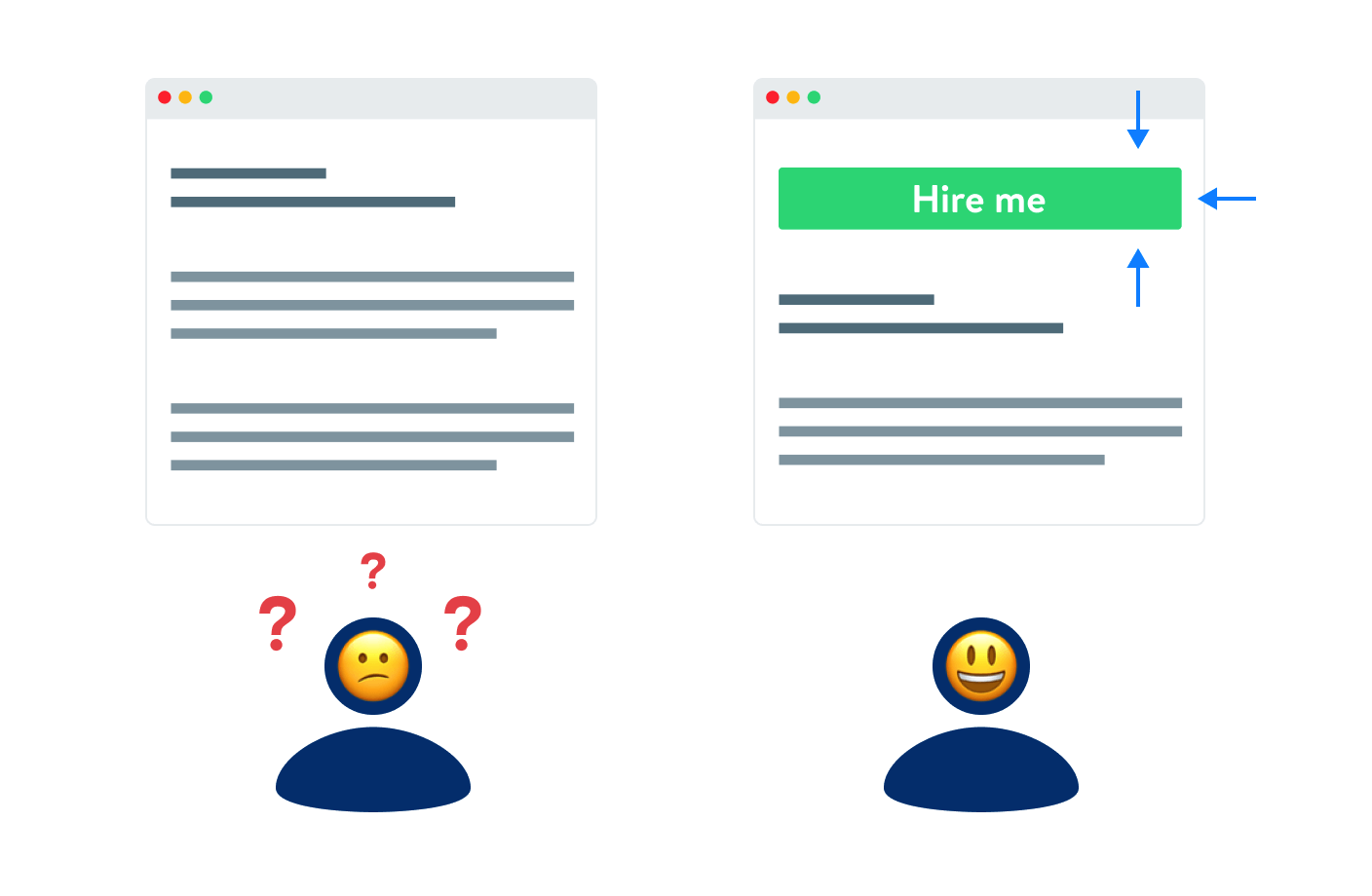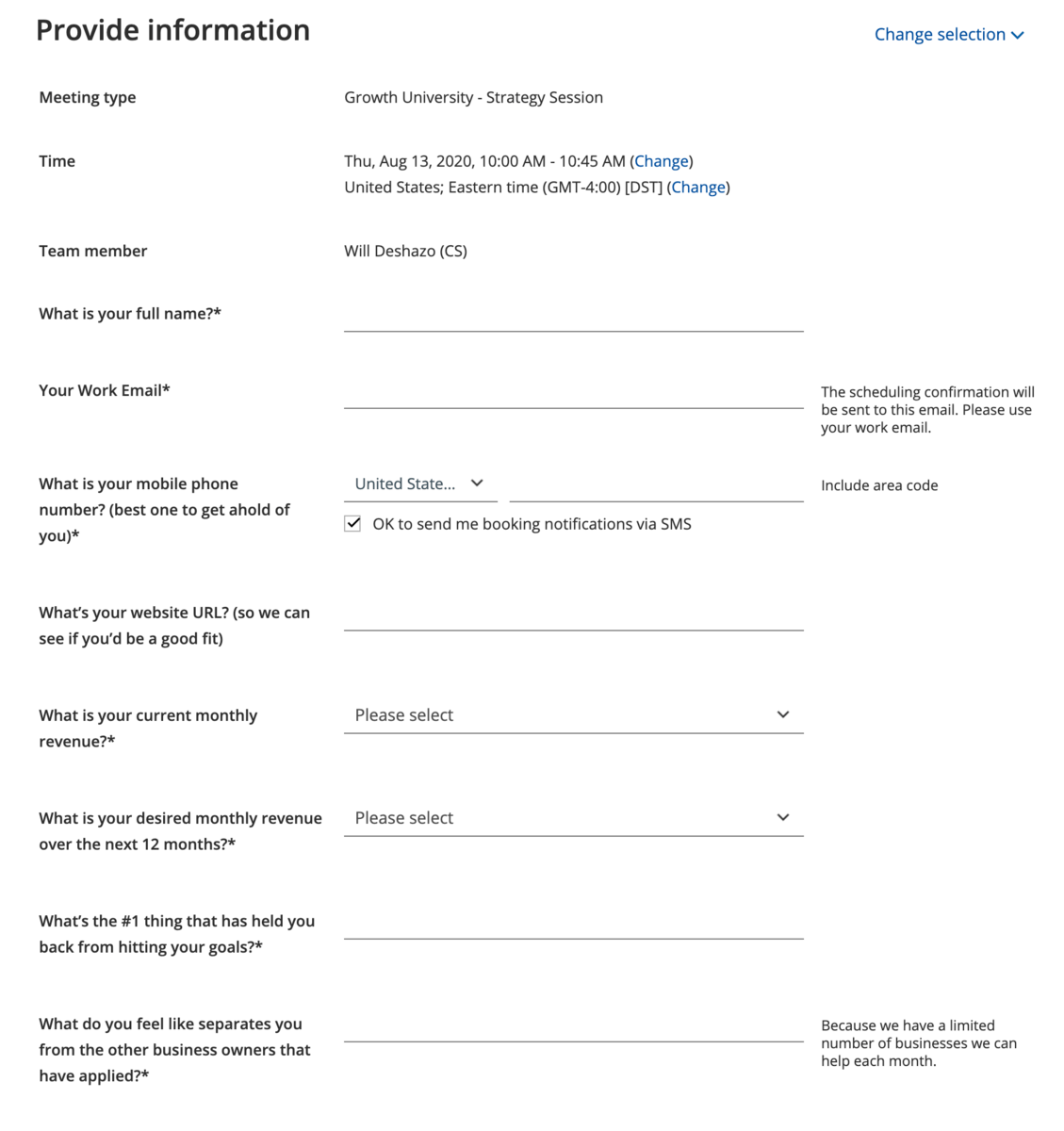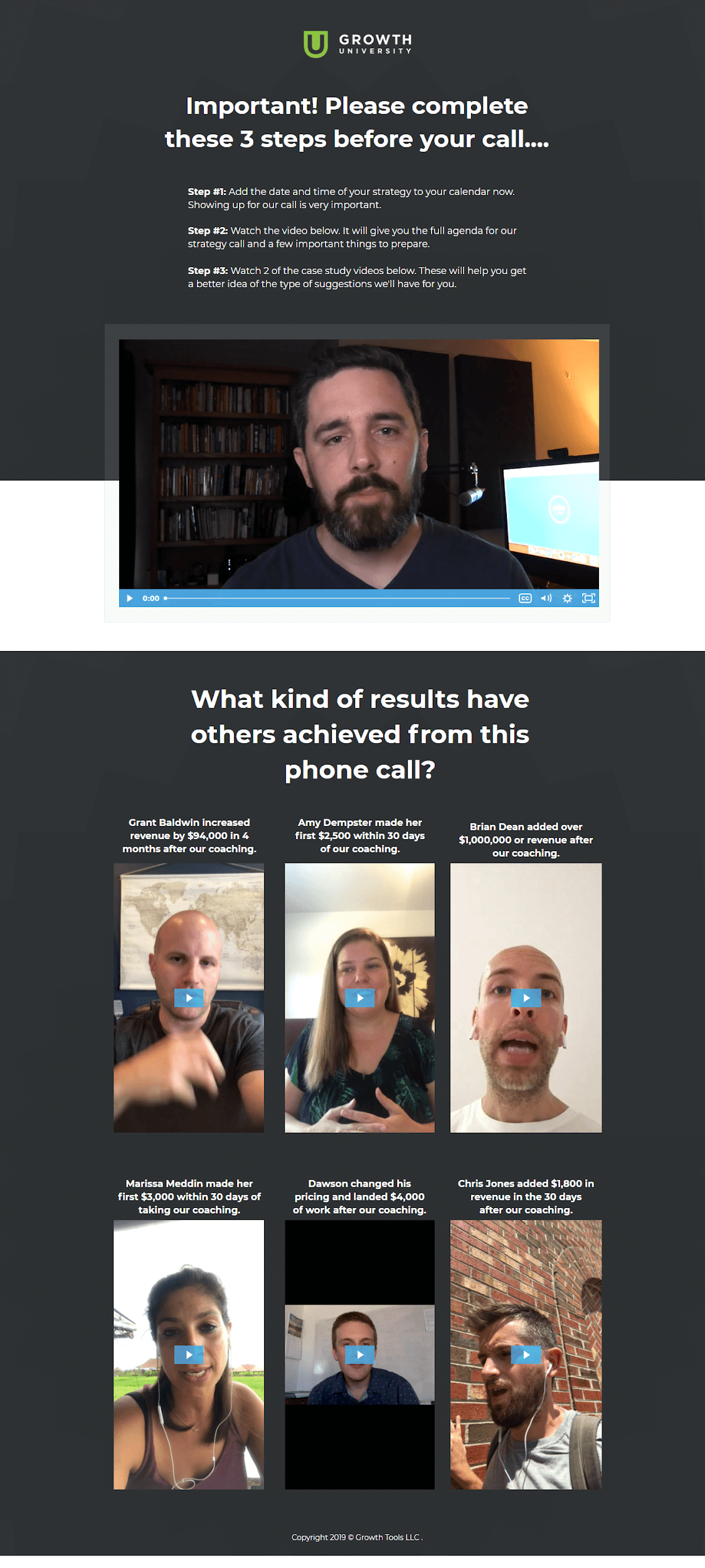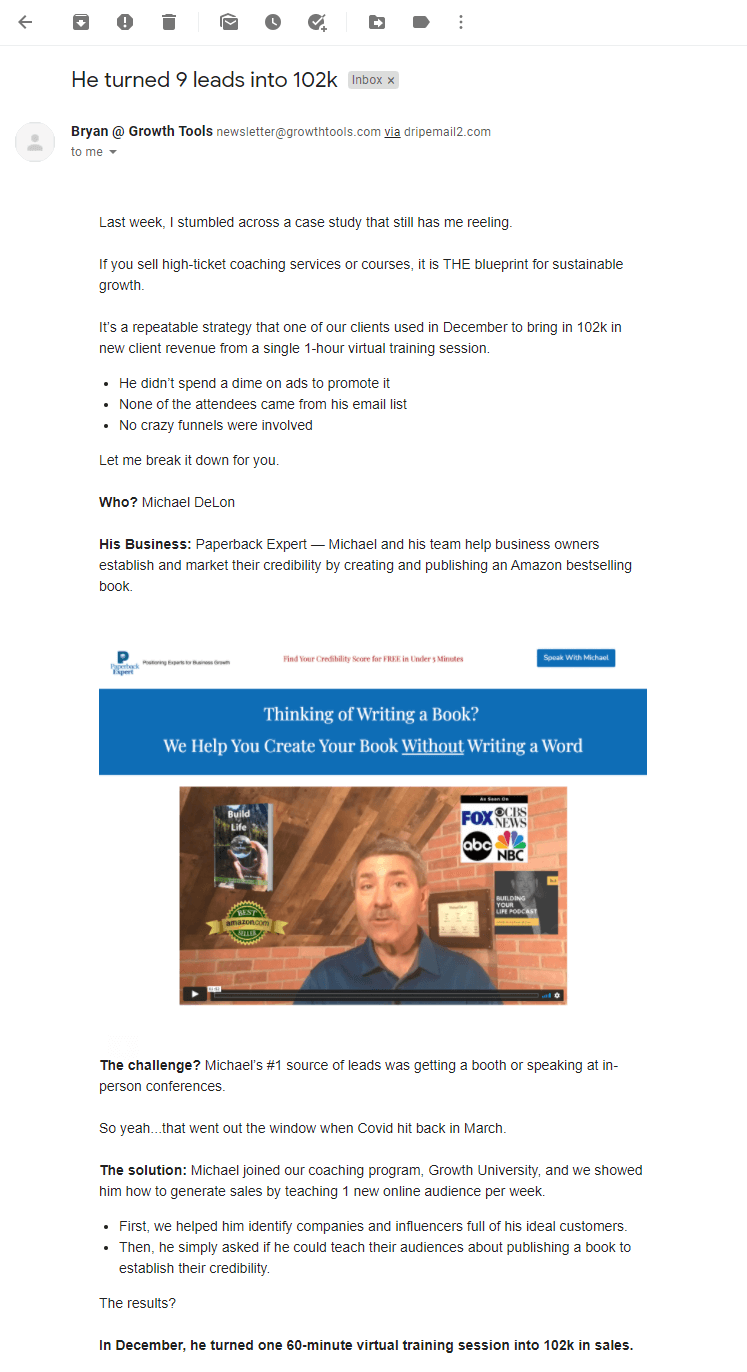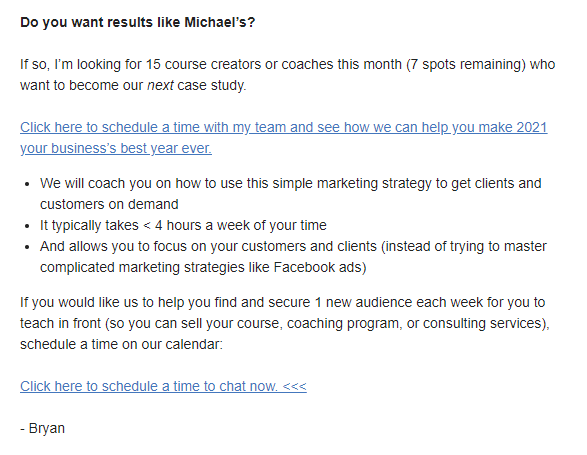Most coaches struggle to convert leads into paying customers for two reasons.
Reason #1: They spend countless hours doing a flurry of activities that look and feel like marketing but don’t produce results.
They do a LinkedIn post here, a Facebook Live there, maybe they email their list twice a month and are guests at a podcast once in a while—all in the hopes that it will lead to paying customers.
Reason #2: Most coaches don’t make it easy for people to hire them.
How can you know if you’re one of these coaches? Answer this question for me:
If I spent only three seconds on your website, would I be able to find how to hire you?
How accessible is your phone number? Do you have a “Hire Me” button in clear, contrasting colors? Can they sign up for your email list easily?
These two issues boil down to a single, root problem: Many coaches don’t have a clear path for leads to become clients.
Fortunately, that’s an easy problem to solve.
If you want your marketing efforts to bring in leads and turn them into clients, you need one good path for all leads to follow, no matter how they find you.
Can you make separate funnels and tweak the copy for each channel? Sure. But you don’t need to make things complicated right now.
Just focus on making one path for all your leads to follow.
Below, I’ll show you exactly how to do just that in three simple steps. I’ll cover topics such as:
- Why your leads aren’t turning into clients.
- The importance of having a “book-a-call” page and how to create one.
- How to create a repeatable marketing strategy that reliably converts leads into clients.
Ready?
Looking for proven, step-by-step methods to grow your coaching business? Book a complimentary strategy session, where we’ll audit your business strategy and talk through a 90-day plan to skyrocket revenue.
Step 0: Choose Which Leads You Want
This article is meant to help you take leads you already gathered and convert them into paying customers. That said, converting leads means having leads in the first place.
If you’re having trouble getting eyeballs on your site, go ahead and read:
- How to Find Your Next 20 Clients Online in 63 Days
- How to Get More Referrals from Clients
- Partnership Marketing 101: How to Book Your First Partnership
- How to Build an Email List: A Proven System for Getting 1,000+ Subscribers
All set?
Now, before you try to convert them into paying customers—pause for a second.
Think about your two worst clients. Would you want more of those?
Heck no.
If you get 100 new leads, I can bet you anything that at least two or three of those nightmare-to-be clients will be in that pool.
So what do you do about it? You set up a process to screen them out.
Screening leads is easy. Create a short questionnaire that all your leads fill it out. Make it at least three questions and, at most, ten.
Set up questions related to your coaching niche. The fastest way to know whether or not a lead is a good fit is to have them tell you.
If, for example, you’re a singing coach: Maybe you ask prospects what kind of experience they have with music, such as if they play any instruments or have ever taken singing lessons. You can then use these answers to filter based on what criteria “tell” you is a good or bad fit for your coaching.
Whether you’re a business coach, a health coach, or any other form of coach—always make one of your questions about finances. The last thing you want is to find out your soon-to-be client doesn’t have the budget to invest in your coaching program.
If you’re wondering what such a questionnaire would look like, here’s an example we use:
One last thing before we move on. When you turn down prospects that aren’t a good fit, don’t alienate them. Send them resources that might help them. In the future, they may become great-fit clients for you.
Once you have a screening process for your leads, it’s time to set up one good path for those leads to follow on their journey of becoming paying clients.
What do I mean by “One Good Path”?
One good path is a process by which you send all leads from your marketing efforts to a central call to action that will help you turn those leads into new business.
This will help you close your best-fit leads, nurture the medium-fit leads, and expel potentially bad clients before you work together.
It only takes three steps to get your path set up:
- Step 1: Create a book-a-call page.
- Step 2: Retarget all leads from your marketing efforts to that page.
- Step 3: Pay attention to what works, and stop doing what doesn’t.
Step 1: Create a Book-a-Call Page
Would you hire someone you don’t trust? Most people wouldn’t. Not only do you need to build trust, but you also need to demonstrate you’ll get along well with a prospective client.
Most coaches accomplish this on a 30- to 60-minute sales call.
That means the book-a-call page should be the center of gravity for all your marketing efforts. It’ll be the place where you redirect all leads to generate calls (and in turn clients), no matter where they come from.
Don’t overthink it. Your book-a-call page only needs to answer two simple questions:
- What is your coaching method?
- Who’s it for?
Have a clear, easy-to-see call to action for your leads to schedule a call. A button that links to a screening survey followed by a calendar will do.
In our experience, those two questions are best answered in the form of a short video (about 10 minutes). Nothing too complex. Just set up an iPhone or webcam, point it at your face, and start talking.
Here are examples from two of our clients.
The first comes from Erin Bader, a leadership and life coach who uses our strategies to build up her client base. She uses this video to give clients an instant win—a tactic they can use to better their lives immediately:
The second example comes from Michael DeLon at PaperbackExpert.com:
Page. Video. Button to schedule a call. That’s all you need for an online coaching business.
You could add testimonials and the like to your book-a-call page. But I’ve learned that those, at best, don’t add too much value and, at worst, distract prospects from the only thing they should be doing: clicking that button to schedule a call.
And one last thing: You also need a “Thank You” page.
You can just say “Thanks for booking a call.” Or you could use it as an opportunity to build excitement for the call. We include next steps, a video to explain them, and video testimonials from our clients. It looks like this:
Now, let’s move on to Step 2.
Step 2: Send Leads to Your Book-a-Call Page
Remember that flurry of activity that brings new leads but doesn’t convert, which I mentioned above? Now that you have your book-a-call page set up, you don’t need to stop doing those—for now, at least.
All you need to do is redirect all leads to your book-a-call page.
How?
Do you like doing Facebook Lives? Awesome. Do Facebook Lives, or Instagram Lives; do them to your heart’s content. Just make sure that, at the beginning and at the end of each, you say something like:
“By the way, if you want me to help you do this, go to mypage.com/apply so we can hop on a call.”
This strategy applies to anything and everything you do that remotely speaks about your business:
- Your current social media following.
- Your email list.
- Your website.
- Your podcast appearances.
- Your blog posts.
Retarget all those to your book-a-call page.
Later in the article, we’ll explain why you should not be doing everything you can to bring in new leads—and instead pay attention to what works best, and stop all marketing activities that don’t properly benefit you.
That way, you can stop wasting time doing things that don’t work, and spend more time making money coaching clients.
Once you’ve retargeted all leads to your book-a-call page, you need to set up a “pre-call hype sequence” to make sure prospects don’t lose interest or forget about the call.
Set Up a ‘Pre-Call Hype Sequence’ to Keep Your Prospects Excited
There’s typically one, two, sometimes even three days that go by between the time a prospect clicks on your “schedule a call” button and the time of the call.
That’s a problem.
In those few days leading up to the call, prospects tend to lose interest. The excitement they felt about you and your business when they decided to schedule the call slowly lessens. Sometimes, they even forget about the call altogether.
I’ve got two pieces of advice to offer.
First—never, and I mean never schedule a call further than four days away.
If four days go by, you can almost guarantee the prospect will lose interest in speaking with you.
Second—keep your prospect interested and engaged so they don’t lose interest or forget about you.
How?
By setting up a “pre-call hype sequence.” 🔥
A pre-call hype sequence is a series of messages you sent to the person who just signed up in the days leading up to the call. A handful will do the trick:
1. Intro and Congratulations Message
Send this immediately after they sign up. You can write something simple, such as:
“Congrats! You made a great choice signing up to learn more about Amy’s 90-day fitness boot camp. We’ll walk through your goals on the call and figure out a free 7-day fitness and nutrition plan just for you.”
2. Case Study Message
Send an email that includes one of your best case studies or success stories ~15 minutes after sign-up. If you have more than one case study or success story, just share what’s most relevant to this prospect.
3. Relevant Blog Post or Other Content
The day before your call, send a second piece of valuable content in the form of a relevant blog post (or YouTube video, or another piece of content.)
This will help remind the prospect exactly how awesome you are, and why they signed up to speak with you in the first place.
4.Reminder for the Call
On the day of the call, send a quick note reminding your prospect when you’re talking, and why.
That’s it. Four simple messages, and I can all but guarantee your prospect will be ready and excited to talk to you once the time of the call comes.
Before we move onto the next step—here are a few marketing strategies you could implement to bring additional prospects through your funnel.
Note: If you’d like to know more about turning leads into customers, check out ourHow to Close Sales Calls post. If you’d like help from one of our expert coaches, schedule a complimentary strategy session today.
Email Your List Regularly
Encourage site visitors and any other leads to sign up for your email list. Once they’re on, ask them to book a call once per week. Some of those emails could be a straightforward invitation to sign up. But others can be more interesting:
- Share a case study.
- Write a how-to post (much like this one).
- Write about a common pain point and one tip to improve it.
You can also use your email list to nurture medium-fit leads that haven’t yet converted to ideal clients.
Just retarget anyone that visits your book-a-call page (but doesn’t sign up) with Facebook ads that send them back to your content and put them in the email list. That way, you can convince them over time to book a call using the methods mentioned above.
Here’s a recent case study I sent to my email list about my client, Michael DeLon:
The email goes on to explain more on how he did it and invites readers to sign up for a free session with my team:
Always, always add a call to action at the end of the email. It can be one sentence or three paragraphs. Tailor it to your audience and writing style. Just make sure it sends your readers straight to your book-a-call page.
Make a List of Dream Clients and Reach Out to Them
This is how I got my first clients when I was first getting started. I simply made a list of 100 dream clients and cold pitched them, one by one.
Just literally email each person from that list, and ask them to be your client. But do it in a way that makes it hard for them to say no.
Back in 2014, I wrote about the “Santa Claus” formula. In it, I go through a few examples of great cold emails and why they work. Here’s one:
If you don’t have any dream clients (yet), then try this:
Step 1: Search for Facebook Groups or other social media groups where like-minded people hang out.
Join those groups. Start commenting and participating until you become an active member of the community.
Step 2: Look for the most active people in that group, and reach out to them.
Once you’ve gotten to know the people in the Facebook Group (and they know you), reach out to them offering your services.
Step 3: Find the group admin and offer to do a live training session for free.
If you’re an active member of the community, the group admin will know who you are and know about your expertise. Most will be happy to let you host a live training session for their group, which in turn will further validate you in the community and give you a chance to offer your coaching services.
The same logic applies to blogs.
Find blogs that fit your expertise and start commenting and answering questions. After a while of doing this, you’ll become an active member of the community around that blog.
All you need to do now is reach out to your fellow active members directly and offer your services. You could also try offering your blogging skills to the blog owner in the form of a guest post.
Here are a few more ways you can get in front of an audience:
1. Teach Once a Week (Facebook or Instagram Live).
By teaching once a week, you’re putting yourself in front of your audience regularly—and each appearance is another chance to gather new leads and convince your current audience to become paying clients.
2. Teach in Another Person’s Group Once a Week.
This is another example of partnership marketing, which you can learn how to do here.
It involves finding audience leaders, pitching them, and teaching their followers something useful. You want it to be a win-win situation the other person can’t turn down. Your pitch might look something like this:
But I’ll let you read all the details on how to find the right people, craft the perfect pitch, and deliver a great presentation in our partnership marketing post.
3. Do a Podcast Interview Once a Week.
Podcast interviews work much like teaching a webinar in front of another coach’s audience (preferably the same target audience as yours). It puts you in front of a new audience you can share your expertise with. Always invite them to learn more on your website, where you will turn them into leads or even paying clients.
Getting invitations to appear on podcasts follows a similar process to that of teaching. For a step-by-step breakdown on how to do partnership marketing, check out our How to Get Booked on Podcasts That Drive Your Online Course or Coaching Sales post.
Now, on to the third and final step.
Step 3: Pay Attention to What Works, and Stop Doing What Doesn’t
If you’ve followed this post and implemented our tactics so far, you’ll have:
- Created a book-a-call page.
- Pointed all your marketing activity back to a central call-to-action on that page.
- Set up a “pre-call hype sequence” that will keep your prospects excited about their calls.
Now look back at your flurry of marketing activity. It’s time you stop doing some of those.
Why?
Marketing takes time. A lot of it.
If you want to be a successful coach, you need to minimize the amount of time you spend doing marketing, and maximize the amount of time spent doing coaching sessions.
But how do you spend less time doing marketing without sacrificing leads?
Easy.
Pay close attention to what brought in potential clients and what didn’t. Then, stop doing what didn’t work, and double down on what did.
Don’t overthink it. This can be as simple as a drop-down in the call application asking where they found out about you.
And it doesn’t even need to be that complex. If you got 10 scheduled calls the day of a Facebook Live, then the Facebook Live is probably working. But if, on the other hand, you’ve done 10 Instagram Lives in the last twenty days, and no new calls were booked…
Maybe it is time to stop doing them.
If you’ve gotten five clients in the last three months who mentioned they decided to work with you after hearing you on podcasts—do more of those.
You don’t need absolute data (though it’s nice to have). You’re looking for trends.
If nobody ever mentions your podcast appearances, you should stop wasting your time doing them, and instead, focus your effort on something that does bring you new clients.
And if you’re not sure, just stop and see what happens.
I still find it shocking how many times I’ve abandoned tactics accidentally or on purpose and, three years later, I’m like, “Oh, yeah, I used to do that. I guess that didn’t work.”
Spend your time on marketing activities that increase your client count. Drop anything that doesn’t get results.
What Are You Waiting for?
Want help implementing the strategy I covered today? Book a complimentary strategy session where we’ll audit your business strategy and talk through a 90-day plan to skyrocket revenue.
